Revised
As a woodland owner, you may hear foresters use unfamiliar terms or see new terms in your forest management plan or timber sale contract. Forestry is a specialized field with its own terms and abbreviations. This guide defines many of the terms and abbreviations commonly used in forestry and woodland management.
Forestry terms
- acceptable growing stock (AGS)
Trees that now have, or could have in the future, one or more desirable characteristics making them suitable for allocation of growing space in a stand. See also growing stock. - acre
An area of land containing 43,560 square feet. An acre can take any shape. If square in shape, it would measure about 209 feet per side. - advanced reproduction
Young trees that are already established in the understory before a timber harvest. - afforestation
Establishing a new forest on land that was formerly not forested, for example, converting a pasture into a forest plantation. - age class
The intervals into which the range of tree ages are grouped, originating from a natural event or human-induced activity.

- annual ring
Annual expansion of tree bole, branches and roots in, normally, visible concentric rings. A combination of earlywood and latewood is one year’s growth. Also called growth ring or annual growth ring. See also earlywood and latewood. - aspect
The direction — north, south, etc. — that a slope faces. - bare-root seedlings
One-year-old trees grown from seed in a nursery and then lifted without soil attached. - basal area (BA)
The cross-sectional area of a tree, in square feet, at 4.5 feet from the ground, or breast height. When the basal areas of all the trees in a stand are summed, the result is expressed as square feet of basal area per acre, which is a measure of a stand’s density.
- basal spray
A method of controlling woody vegetation whereby herbicide is applied directly to the lower portion of the plant and is absorbed through the bark. - best management practices (BMP)
Practices used to protect water quality during timber harvests and other forest management activities. - Biltmore stick
A graduated stick used to estimate tree diameters by holding it against the tree at breast height. See also diameter at breast height. - biodiversity
The richness and abundance of species and the variety of natural communities in a forest environment. Both the number of species and the number of individuals of each species affect the extent of biological diversity in an area. - biomass
Plant components that are used as a raw material for processing into energy or fuels.
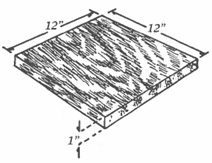
- board foot
A unit for measuring wood volumes. It is commonly used to express the amount of wood in a tree, sawlog or individual piece of lumber. A piece of wood 1 foot long, 1 foot wide and 1 inch thick, or 144 cubic inches. - bole
The main tree trunk. - bolt
A short log or a squared timber cut from a log, usually less than 8 feet long. - browse
Twigs and buds of small shrubs and trees that are eaten by deer and livestock. - buck
To saw felled trees into shorter lengths. - buffer strip
A protective strip of land or timber adjacent to an area requiring attention or protection, for example, a protective strip of unharvested timber along a stream. - butt
The base of a tree. Once felled, the butt log is the one that was attached to the stump. - cambium
The growing layer of cells beneath the bark of a tree from which develop new wood and bark, or xylem and phloem, respectively. - canopy
The uppermost layer in a forest, formed collectively by tree crowns. - cant
The interior lumber that remains after the boards are sawn from the sides of a log. - catface
A scar on the bole of a tree that resulted from a pruning wound or natural death of a branch and is partially or fully covered over with new growth. - certified forest
A forest enrolled in a voluntary system that promotes sustainable forest management that is assessed by an independent third party. - cavity tree
A tree containing cavities that are used by wildlife for nesting and protection. Also called a den tree. - chain
A unit for measuring land distance. A chain is 66 feet. An acre contains an area equal to 10 square chains.

- clearcut harvest
An even-aged method of harvesting trees removing all the trees in one operation. Clearcutting is commonly used to reproduce shade-intolerant species that require full sunlight to germinate and grow well. See also even-aged management. - climax forest
The final stage of forest succession, usually composed of shade-tolerant species that are self-perpetuating without a disturbance. - clinometer
An instrument for measuring vertical angles or slopes. - closed forest
A forest where the tree canopy is dense and the branches and leaves of the trees form a continuous cover, limiting sunlight penetration to the forest floor. See also forest. - codominant trees
Trees that form the general level of the canopy but are below the dominants, receiving sunlight from above their crown and some from the side. See also crown class. - conifers
See softwood. - cord
A stack of wood containing 128 cubic feet. A standard cord measures 4 feet by 4 feet by 8 feet of wood and air. - crop tree
A tree selected for its desirable characteristics and potential to meet landowner goals — such as timber production, wildlife habitat or aesthetic appeal — and managed to thrive through techniques such as crop tree release. - crop tree release (CTR)
A thinning technique whereby specific, desirable trees (i.e., crop trees) are favored by removing competing trees whose crowns are touching the crop trees’ crowns, thus allowing the crop trees to expand their crowns and grow more efficiently. See also thinning. - cross-tie
A cant used as a cross member supporting railroad rails. Also called a tie. - crown
The branches and foliage of a tree.

- crown class
A relative designation of tree crowns, broken into distinct layers. See also codominant trees, dominant trees, intermediate trees and suppressed trees. - cruise
Also referred to as a forest inventory, it is the process of sampling a forest or forest stand, used to estimate wood volume and value and to make forest management recommendations. See also fixed-radius plot and variable-radius plot. - cull
A tree or log of merchantable size that, because of a defect, is useless for its intended purpose. - defect
That portion of a tree or log that makes it unusable for the intended product. Defects include rot, crookedness, cavities and cracks. - den tree
See cavity tree. - diameter at breast height (dbh)
The outside-of-the-bark diameter of a tree measured at 4.5 feet above the ground on the uphill side of the tree. - diameter inside bark (dib)
The diameter inside the bark of a log, measured at the small end. - diameter tape (D-tape)
A specially graduated tape used to determine tree diameter when stretched around the circumference of the tree stem. - dibble bar
A flat or round metal tool used to make holes for planting seedlings. Also called a planting bar. - direct seeding
The process of regenerating a forest by sowing seed (as opposed to planting seedlings or allowing for natural regeneration). - directional felling
Careful tree cutting to ensure that trees fall in a predetermined direction in order to protect the residual trees from logging damage and to allow for easier log skidding. - dominant trees
Trees much taller than the general level of the canopy, receiving direct sunlight on all sides of their crown. See also crown class. - dote
The early stage of tree rot having discolored and/or often soft wood. - Doyle rule
This log rule underestimates lumber volume in small logs and overestimates volume in large logs. See also log rules. - earlywood
Part of the annual wood growth ring formed early in the growing season that is differentiated from latewood in that the wood is often less dense and lighter in color. See also annual ring. - edge
In wildlife management, the area where the variety of types of food, cover, water or terrain required by a particular species come together. - ephemeral stream
A stream in which water flows in a diffuse manner over depressions in the forest floor, usually not within a well-defined channel, only in direct response to a major rainfall and only for a short period after rainfall ceases. - epicormic branch
Spontaneous branches that arise from a tree bole, often after exposure to increased light or stress. - even-aged management
Forest management with periodic harvest of all trees on part of the forest at one time or over a short period to produce stands containing trees all the same or nearly the same age or size. Clearcut, seed-tree and shelterwood harvests give rise to even-aged forests. See also clearcut harvest, seed-tree harvest and shelterwood harvest. - exotic invasive species
A species that becomes established outside its natural range, forms a breeding population, and becomes a pest that may threaten the biodiversity of the local ecosystem. - firebreak
A barrier, either existing prior to or constructed during a fire, from which all or most of the flammable materials have been removed, designed to help firefighters in stopping or slowing fire spread. - firsts and seconds (FAS)
The highest standard grade for hardwood lumber. - fixed-radius plot
See forest inventory. - forest
A plant community dominated by trees and other woody plants. See also closed forest and open forest. - forest health
A generally observed, somewhat subjective condition whereby the forest is evaluated according to its age, growth, diversity, existence (or absence) of injurious insects, diseases, exotic invasive pests, wildlife attributes, aesthetics, degree of resiliency, etc., all of which are weighed against the land management goals. - forest inventory
A systematic collection of data and forest information for assessment or analysis. The data can be collected using fixed-radius plots, in which a specific radius defines a plot’s boundary, and all trees within that radius are measured and tallied; or variable-radius plots, in which a prism or angle gauge determines which trees are “in” a plot based on their diameter and distance from the plot center. - forest stand improvement (FSI)
A more encompassing cultural practice compared to timber stand improvement (TSI) to meet a nontimber objective, such as improved wildlife habitat or enhanced aesthetics. See also timber stand improvement. - forest type
A group of tree species that, because of their environmental requirements, commonly grow together, for example, the oak-hickory type. - fragmentation
The breaking up of large forest areas into smaller units either by natural processes or through conversion to other land uses. Natural habitats may become separated into isolated fragments or “islands.” - frill
A cut made with a hatchet or ax completely encircling the trunk of a tree through the bark and into the wood where herbicide is applied, for deadening the tree. It is shallower than a girdle. - frost crack
A crack in the bark of a tree extending from near the base upward, occurring in winter when temperatures fluctuate below and above freezing. - fully stocked
A stand where trees effectively occupy most of the growing space, yet space remains for further crown expansion and growth of developing crop trees. For example, a stand fully stocked at 70% can grow suitably until reaching 100% stocking. See also stand stocking. - girdle
A cut usually made with a chainsaw completely encircling the trunk of a tree through the bark and into the wood where herbicide is applied, for deadening the tree. It is deeper than a frill.
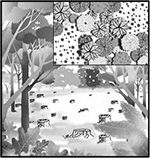
- group selection harvest
An uneven-aged method of harvesting trees in small groups, usually 1 acre or less. See also uneven-aged management. - growing stock
All the trees growing in a stand, generally expressed in terms of number, basal area or volume. Growing stock is often separated into acceptable or unacceptable based on species composition, health and form, and/or in reaching landowner goals. See also acceptable growing stock and unacceptable growing stock. - growth ring
See annual ring. - habitat
The type of place in which the plant or animal lives, such as forest habitat, grassland habitat and marsh habitat. - hardwood
A term describing broad-leaved trees, usually deciduous, such as oaks, maples and ashes. - harvest
The removal of some or all trees on an area. It can mean removing trees on an area to obtain income, regenerate the forest, or develop special wildlife habitat. - heartwood
The inner core of a woody stem, composed of nonliving cells and sometimes differentiated from the sapwood by darker color. - high-grading
A harvesting technique that removes only the best, most valuable trees to obtain high, short-term financial returns at the expense of reducing future growth and revenue potential. - hypsometer
A graduated stick used to estimate tree height. It is often combined with a Biltmore stick. - increment borer
A hollow, auger instrument used to bore into a tree to remove a sample of wood (core) that is used to evaluate growth rate and age. - integrated pest management (IPM)
A comprehensive approach to pest control that prioritizes environmentally sound and sustainable strategies, combining various techniques like biological control, habitat manipulation, and cultural practices to minimize pest populations and damage, while reducing reliance on pesticides. - intermediate cut
Removing immature trees between the stages of stand establishment and final stand harvest, to improve the quality of or reduce competition among the remaining trees. In contrast to a harvest cut, an intermediate cut may or may not generate income. - intermediate trees
Trees with crowns that fall below the general level of the canopy, receiving sunlight only from above at midday. See also crown class. - intermittent stream
Streams containing water within a well-defined channel and flow in response to seasonal variation in precipitation following a major rainstorm or as long as ground water is abundant. - International ¼-inch rule
This log rule is generally considered the most accurate log rule and works well across a wide range of log diameters. See also log rules. - j-root
The shape that a seedling root takes when it is improperly planted by forcing it into a planting hole. - juvenile wood
The first 10 to 15 years of wood growth surrounding the center, or pith, of a tree. This wood generally has poor properties compared with the “mature wood” formed subsequently. - landing
A place where logs are taken to be loaded on trucks for transport to the mill. - latewood
Part of the annual wood growth ring formed later in the growing season that is differentiated from earlywood in that the wood is often more dense and darker in color. See also annual ring. - live crown ratio
A measure of vertical crown length relative to total tree height. Low live crown ratios suggest slow tree growth and may indicate that thinning is needed. A 100-foot- tall tree with the upper 40 feet in living branches would have a 40% live crown ratio. - log rules
A table showing estimated amount of lumber that can be sawed from logs of given lengths and diameters. The two log rules commonly used in Missouri are Doyle and International ¼-inch. See also Doyle rule and International ¼-inch rule. - lump-sum timber sale
When a timber buyer and a seller agree on a fixed price for designated timber that is paid in full prior to the timber being harvested. Often the timber to be harvested has been marked in advance of the sale. - marking timber
The process of selecting, usually by painting, trees to be cut (or retained) in a harvest operation. - mast
Tree fruits, either hard (hickories and oaks) or soft (persimmon and cherry). - merchantable height
The height above the ground level to which the tree can be cut and sold for commercial products. - midstory
The layer of vegetation existing between the smallest, or the understory, and tallest, or overstory, trees in a forest. - natural regeneration
Trees that become established because of natural seeding or sprouting, as opposed to being planted. - noncommercial thinning
Cutting, or deadening, trees to improve growth conditions of the remaining trees. The practice does not produce income, usually because the trees cut are too small for marketability. Also called precommercial thinning. - on the stump
Standing, uncut timber. See also stumpage. - open forest
A forest characterized by a relatively sparse tree canopy, allowing significant sunlight to reach the forest floor, often with a grassy or shrubby ground layer. Also called a woodland. See also forest. - organic matter
Material produced by plants and animals — such as leaves, branches, bark, wood, hair, fur and bones — that is incorporated into the soil. - overstocked
A stand that is overcrowded, beyond 100% stocking, thus reducing tree growth and vigor. See also stand stocking. - overstory
That portion of the trees in a stand forming the upper crown cover. - pay-as-cut sale
Timber buyer agrees to pay the landowner for designated timber on a per unit basis as the timber is being harvested. This is opposed to a lump- sum sale, where the timber is paid for in full prior to being harvested. - pioneers
Shade-intolerant species that are the first trees to invade a freshly disturbed or abandoned site. An example is eastern cottonwood. - planting bar
See dibble bar. - plot
An area where data are collected to provide information about the forest. Several plots constitute a forest inventory. - pole
A tree from 6 to 12 inches in diameter. See also size class. - precommercial thinning
See noncommerical thinning. - prescribed fire
A fire intentionally set under appropriate weather, soil moisture, wind and supervision in order to accomplish specific silvicultural, wildlife or fire-hazard-reduction goals. - prism
A small glass wedge through which light refracts that is used in a forest inventory. A prism wedge helps determine which trees are to be included in a variable-radius plot. - pulpwood
Wood that is cut primarily for the manufacture of paper, fiberboard or other wood fiber products. Pulpwood is normally small in diameter. - punky
A soft, weak, often spongy condition in wood that is caused by decay fungi. - recruitment
The process of smaller trees growing into larger size classes. - reforestation
Reestablishing a forest on an area where forest vegetation has been removed. - regeneration
The process of forest replacement or renewal. Trees become established from seeds, sprouts, planting and/or advanced reproduction. - release cutting
Improving the composition in young stands by cutting inferior trees, thereby releasing the desired trees from competition. - reproduction
Young trees, seedlings and saplings in a forest setting. - residual
Trees remaining in a stand after cutting. - riparian zone
Pertaining to the area along the banks of a river, stream or lake, normally offering some protection from forestry activities via the use of buffers. - root collar
On a seedling, the transition between the stem and the root, usually recognizable by a slight swelling. - rotation
The number of years required to establish and grow trees to a specified size, product or condition of maturity. Oaks may have an 80-year rotation for sawlogs whereas Scotch pine may have a 10-year rotation for Christmas trees. - roundwood
Wood products that are round, such as pulpwood, posts, pilings, utility poles and fencing material. - salvage cut
Harvesting damaged trees (i.e., from tornado or fire) to gain their economic value, often benefiting the residual stand. - sanitation cut
A harvest done as a precautionary mechanism to remove potentially highly susceptible trees from oncoming insects or disease before trees become infected by the pest organism. - sapling
A tree from 1 to 5 inches in diameter. See also size class. - sapwood
The light-colored section of the tree between the heartwood and the bark also known as xylem. Contains some living cells and conducts water to the crown for photosynthesis. - sawtimber
A tree greater than 12 inches in diameter. See also size class. - scaling
Estimating the usable wood volume in a log or standing tree that follows fundamental rules. - scarify
Disturbing the forest floor to expose bare ground for regeneration.
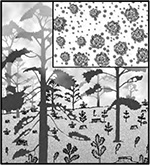
- seed-tree harvest
An even-aged method of harvesting by removing nearly all trees from the harvest area at one time but leaving a few scattered trees to provide seed for a new forest. See also even-aged management. - seedling
A tree, usually less than an inch in diameter, and no more than 3 feet in height, that has grown from seed. Also, trees grown in a nursery for one or more years. - seed source
The location from which seeds are collected or are dispersed. An individual tree can also be a seed source. - shade tolerance
The capacity of a tree to develop and grow in the shade of and in competition with other trees. An example of a tree with high shade tolerance is sugar maple. An example of a tree with low shade tolerance is eastern cottonwood.
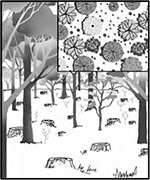
- shelterwood harvest
An even-aged method of harvesting trees in a series of two or more operations. Initial harvesting allows new seedlings to grow and become established in the partial shade protection of older trees. Once the seedlings are established, the overstory trees are then harvested. See also even-aged management. - silvics
The study of trees, their environment and the development of forests that becomes the basis for practicing silviculture. - silviculture
The art and science of producing and tending a forest. - silvicultural system
A planned program of treatments during the entire life of a stand designed to achieve specific objectives.
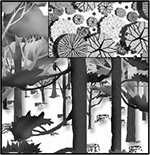
- single-tree selection harvest
An uneven-aged method of harvesting individual trees at intervals based primarily on their vigor and age. Trees are removed across all age classes. See also uneven-aged management. - site
An area evaluated for its ability to produce a particular forest or other vegetation based on the combination of biological, climatic and soil factors. - site index
An expression of forest site quality based on the average height of the dominant and codominant trees of a specific species in the stand at a specified base age, usually 50 years. For instance, when upland red oak trees are 85 feet tall at 50 years, the site index for that group of trees is 85. - site preparation
Preparing an area of land for forest establishment. May include clearing, chemical vegetation control or burning. - size class
A classification of trees based on their diameter at breast height (dbh), which is the diameter measured at 4.5 feet above the ground, to categorize trees into groups. See also pole, sapling and sawtimber. - skid trail
A road or trail over which equipment or horses drag logs from the stump to a landing. - skidding
Pulling logs from where they are cut to a landing or mill. - slash
Debris left after logging, pruning, thinning or brush cutting. May include tree tops, branches or bark or debris left after wind or fire damage. - slope
The incline of the terrain, usually expressed as the change in elevation, in feet, over 100 feet of horizontal distance. - streamside management zone (SMZ)
A buffer strip of trees or other vegetation that is intentionally left, or disturbed lightly, around rivers, streams, lakes or other bodies of water to protect water quality. - snag
A standing dead tree from which leaves and most of the branches have fallen. Used for wildlife. - softwood
A term describing trees with needles or scales. Also called conifers. - soil horizons
Distinct layers of the soil during soil formation that differ one from another and vary in physical, chemical and biological properties. - soil texture
The proportion of sand, silt and clay in soil. High amount of sand is considered coarse soil while high amount of clay is fine soil. - stand
A grouping of trees with similar characteristics — such as species, age or condition — that can be distinguished from adjacent groups. A stand is usually treated as a single unit in a management plan. - stand density
A component of stand stocking, or the number of trees in a given area. - stave bolts
Material cut from the white oak group and used in the manufacture of wooden barrels. - stand stocking
The number of trees in a stand in relation to the desirable number of trees for best growth and management. See also fully stocked, overstocked and understocked. - stumpage
The monetary value of a tree or group of trees while in the woods uncut, or standing on the stump. - succession
The process of one plant community modifying the environment in such a way that favors the establishment and eventual domination of another plant community. One overtakes another, which is then overtaken by another. - suppressed trees
Trees much shorter than the general level of the canopy, receiving only filtered sunlight. See also crown class. - taper
The gradual reduction in diameter of a tree bole progressing from the base upward. - thinning
Tree removal in an immature forest stand that reduces tree density and between-tree competition. Proper thinning encourages increased growth of fewer but higher quality trees. - thousand board feet (MBF)
A standard unit of lumber and log volume. See also board foot. - tie
See cross-tie. - timber stand improvement (TSI)
Applying cultural practices to a forest to improve the composition, stocking and growth of trees. Practices may include removing vines, thinning and pruning. - unacceptable growing stock (UGS)
Trees of low quality or less valuable species that should be removed in a thinning. See also growing stock. - underplanting
Planting seedlings under an existing stand of trees, often with the intent of later releasing the seedlings by removing/harvesting the overstory. Also referred to as enrichment planting. - understocked
A forest stand insufficiently stocked with trees. See also stand stocking. - understory
That portion of the trees or other vegetation existing below the midstory and canopy in a forest. - uneven-aged management
Managing a forest by periodically harvesting trees of all ages to maintain a broad age or size class distribution. Group and single-tree selection harvests give rise to unevenly aged forests. See also group harvest and single-tree selection harvest. - variable-radius plot
See forest inventory. - veneer
A thin sheet of wood sliced or peeled on a veneer machine and often used for plywood or for surfacing furniture. - veneer log
A large (usually more than 18 inches in diameter), knot-free, high-quality log from which veneer is obtained. - volume
The amount of wood in a tree, stand of trees or log according to some unit of measurement, such as board foot, cubic foot, etc. - volume table
A table estimating the volume of wood in a standing tree based on diameter and merchantable height. - watershed
An area of land that collects and discharges water into a single stream or other outlet. - widowmaker
A limb, top, leaning tree or other material in the forest that is in danger of falling to the ground without warning, thus creating a safety hazard. - windthrow
Trees blown over or knocked down by high wind, snow or ice. - wolf tree
A living tree occupying more space in the forest than its economic value justifies. Usually older, larger or with more branches than other trees in the stand. - woodland
See open forest.